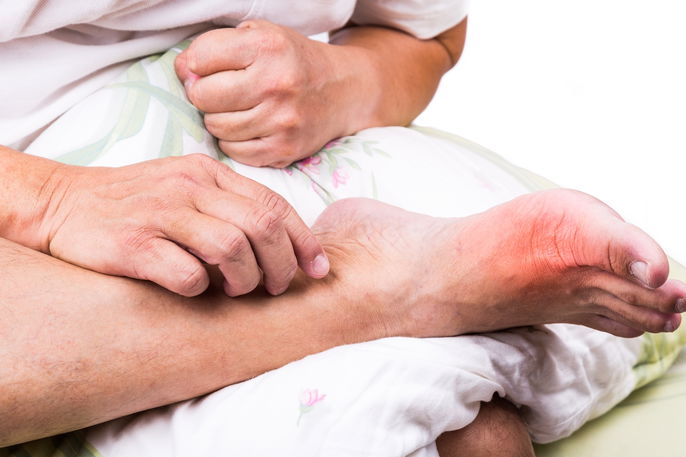What is it:
Gout is an inflammatory disease that affects the joints and is characterized by elevated levels of uric acid in the blood, also known as hyperuricemia. With gout, uric acid levels are usually higher than 360 umol/L for women, and higher than 430 umol/L for men. Symptoms include swelling, redness, and pain when moving the affected joint. The base of the big toe is the joint that is most affected and can interfere with walking.
It's important to highlight that not everyone with high uric acid levels will develop gout, as there are many other factors involved with the development of this condition
To reduce the symptoms caused by gout, dietary changes aimed at reducing uric acid levels are advised. The doctor may also prescribe anti-inflammatory medication to control intense pain and inflammation. Many patients may also benefit from adhering to a gout diet.

What causes gout?
Hyperuricemia, which is an increase in uric acid levels in the blood, is what leads to gout and its associated symptoms. Hyperuricemia can happen due to an increase in uric acid production, or through decreased elimination of this substance from the body.
Other causes include:
- Inappropriate use of medication;
- Excess use of diuretics;
- Alcohol abuse;
- A high protein diet, with frequent consumption of red meat, seafood, and legumes like peas, beans, or lentils;
- Diabetes;
- Obesity;
- Uncontrolled high blood pressure;
- Atheroclerosis.
Due to the high amounts of circulating uric acid, monosodium urate crystals (the crystallized form of uric acid) deposit in the joints, especially the big toe, ankles, and knees.
Gout is more common in patients who are overweight or obese, those who have a sedentary life, and those that have chronic diseases that are not well-managed. In addition, gout is more common in men between 40 and 50 years old, and women after menopause, usually from 60 years old.
Main symptoms
Symptoms of gout happen when uric acid crystals deposit in the joints, resulting in intense joint pain, and which gets worse with movement. Other common joint symptoms include:
- Redness over the joint;
- Swelling;
- Increase in temperature.
The pain, which usually occurs very early in the morning, is intense enough to wake the person up and can last from 12 to 24 hours. After the pain ceases, however, the person can continue to feel discomfort in the affected joint, especially when moving, and this can last for several days few days, especially if the condition is not treated properly.
Any joint can be affected, however, gout is more frequent in the lower body joints, especially the big toe. There may also be kidney stones and uric acid crystal deposits under the skin, forming lumps in the fingers, elbows, knees, toes, feet, and ears.
Confirming a diagnosis
Gout is confirmed through an evaluation of the patient's clinical history, physical exam, uric acid in urine tests, and x-rays. The gold standard for gout diagnosis is the observation of urate crystals in joint fluid through microscopy.
Treatment options
Gout treatment can be divided into two stages: managing the acute crisis and long-term therapy. Treatment for gout crises involves the use of anti-inflammatory medication prescribed by a doctor, such as ibuprofen, or naproxen, to relieve pain and inflammation in the joint. Another anti-inflammatory medication that is commonly used to manage pain and inflammation is colchicine, which also acts directly on uric acid.
Corticosteroid medication, such as prednisone, can also be used to treat pain and inflammation in the joint, however, this type of medication is usually only used when the patient can't take other anti-inflammatory medication, or when the other medication does not have the desired effect.
Besides these medications, a rheumatologist or G.P. may also prescribe medication to control uric acid levels in the blood to avoid new crises from happening and to prevent complications, such as allopurinol or probenecid.
It's also important to change dietary habits, as this can impact the levels of circulating uric acid and the formation of crystals. Conditions like hypertension and diabetes can also influence the occurrence of gout if not treated, and therefore should be well-managed.
Foods to avoid
To relieve symptoms and avoid a new crisis, it's important to alter your diet to regulate uric acid levels.
You should decrease your intake of foods rich in purines, such as cheese, lentils, soya, red meat, or seafood, as purines increase the levels of uric acid in the blood. You should also aim to drink around 2 to 4 liters of water per day, as water helps remove excess uric acid from the urine.
Learn more about what you should avoid and what you can eat to help treat gout.






























